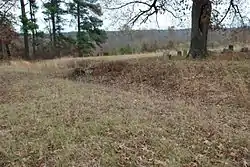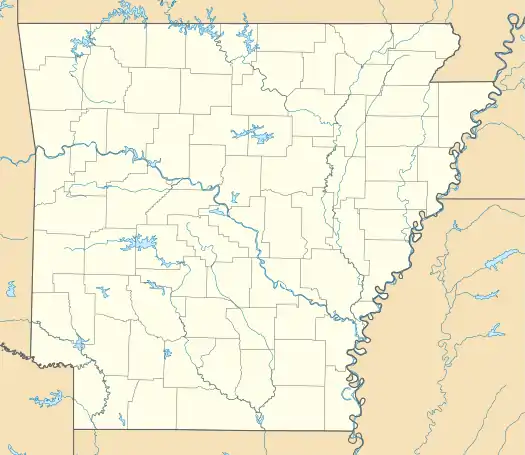Dooley's Ferry Fortifications Historic District
The Dooley's Ferry Fortifications Historic District encompasses a series of military earthworks erected in southwestern Arkansas, along the Red River in Hempstead County. They were constructed in late 1864 by Confederate troops under orders from Major-General John B. Magruder as a defense against the potential movements of Union Army forces toward Shreveport, Louisiana. They command a formerly major road intersection just east of Dooley's Ferry, one of the most important regional crossings of the Red River. After the war a cemetery for African-Americans (known as the Dooley Hill Cemetery[2]) was established adjacent to one of the gun emplacements.[3]
Dooley's Ferry Fortifications Historic District | |
 Cemetery with earthworks | |
  | |
| Nearest city | Spring Hill |
|---|---|
| Coordinates | 33°30′34.097″N 93°43′03.902″W |
| Area | 24 acres (9.7 ha) |
| NRHP reference No. | 04001031[1] |
| Added to NRHP | September 22, 2004 |
The fortifications were listed on the National Register of Historic Places in 2004.[1]
Gallery
 Thomas Dooley 1837 Land Patent.
Thomas Dooley 1837 Land Patent. Thomas Dooley 1839 Land Patent.
Thomas Dooley 1839 Land Patent. Map circa 1861–1865.
Map circa 1861–1865. Survey map 1900.
Survey map 1900.
References
- "National Register Information System". National Register of Historic Places. National Park Service. July 9, 2010.
- "Dooley Hill Cemetery (33.507375,-93.700960)". Find A Grave. Retrieved 25 July 2016.
- "Summary description for Dooley's Ferry Fortifications Historic District". Arkansas Preservation. Archived from the original on 2014-09-16. Retrieved 2014-09-16.
Further reading
- Christ, Mark K. (June 11, 2015). "Dooley's Ferry Fortifications Historic District". Encyclopedia of Arkansas History & Culture. Central Arkansas Library System.
- Environs of Dooley's Ferry, Ark., by M. A. Miller (Map). 1:2000. Confederate States. War department. Department of West Louisiana and Arkansas. May 20, 1864. Retrieved February 25, 2019 – via University of North Carolina at Chapel Hill. Library. Southern Historical Collection.
This article is issued from Wikipedia. The text is licensed under Creative Commons - Attribution - Sharealike. Additional terms may apply for the media files.